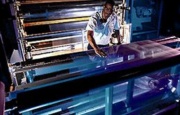Aclar
Description
[Honeywell] A registered trademark for a moisture barrier film made from Polychlorotrifluoroethylene (PCTFE). Aclar films contain only PCTFE as an excellent moisture barrier that is thermoformable and used in many many packing applications. As such, Aclar is used in pharmaceutical, medical, electronics, and military packaging.
To provide an additional oxygen barrier, Honeywell recommends that Aclar is laminated with another substrate, such as PVC, EVOH, PE, Nylon, etc. Several companies provide laminated versions of Aclar. the PCTFE is laminated with Polyester (PET), then sandwiched between two layers of Polyethylene (PE). The multifilm laminate film provide a thermoformable, clear, barrier for oxygen and water vapor.
Examples of PCTFE laminate films as both moisture and oxygen barriers:
| Tradenames | Composition layers | Thickness (mils) | Water-vapor transmission gm/m2 per 24 hours | Oxygen transmission cc/m2 per 24 hours | Data sheet link |
|---|---|---|---|---|---|
| Aclar UltRX 600 | A transparent, single layer barrier film for moisture and oxygen that is heat-sealable. Polychlorotrifluoroethylene homopolymer |
6.0 Mils | 0.0047 (25°C 60%RH) | 27.9 | Data sheet |
| Peralux | A two layer product with very good thermoformability. PVC/Aclar |
6.0 Mils | 0.03 (90% RH, 100°F) | 14.8 | Datasheet |
| Pentapharm | Crystal clear, biochemically inert, thermally stable with unsurpassed protection against moisture and oxygen. Polyvinyl chloride (PVC)/Aclar/PVdC/PVC |
3.0 Mils | 0.35 (38°C 90%RH) | 0.18 | Data sheet |
| Filmpak 1193 | A transparent, multi-layer barrier film that is easier to heat seal than Aclar |
4.9 Mils | 0.03 (90% RH, 100°F) | 0.05 | Datasheet |
Synonyms and Related Terms
PCTFE; Arclar(sp); Alcar (sp); thermoform barrier film; moisture barrier film
Collection Risks
Inert, non-flammable, solvent resistant.[1]
Physical and Chemical Properties
- Extremely low permeability to water vapor and other gases
- Does not crack in extreme cold
- Sterilizable by heat, gas and radiation (below 2 MR)
- Non-flammable
- Extremely inert and solvent resistant
- Heat-sealable
For 0.9 mil film:
- Oxygen transmission: 13.9 ml/m²d
- Water vapor transmission @77F (25C) / 60% RH: 0.028 gms/m²/day
Working Properties
- Aclar is harder to seal than polyethylene and must be at 485 degrees F for one second at 50 psi (Burke, 1992).
- Typically used in combination with Marvelseal for making anoxic enclosures for treating objects with insect infestations/pests. [2]
- Can be laminated to a multitude of substrates, including Polyvinyl chloride (PVC), Polyethylene terephthalate (PET), Polypropylene (PP), cyclic olefin copolymer (COC) and Ethylene vinyl alcohol (EVOH) to add an oxygen and light barrier or create a more sustainable packaging solution for your application.[3]
Exhibit Construction Reviews/Tips/Case Studies
An open-ended heat sealer works well to seal Aclar and allows for custom bag shapes to fit objects.[4]
Resources and Citations
- Aclar: Website
- Honeywell press release, February 2019: "Honeywell Introduces Pharma Packaging Innovation with Aclar Accel"
- Honeywell product brochure: Introducing Aclar Accel, Films for high barrier packaging solutions
- Professional Plastics, Inc. Data Sheet: Aclar® PCTFE Film
KPfilms: Aclar laminated films
- Kaela Nurmi, contributed information, MWG group, 2020.
- Dictionary of Building Preservation, Ward Bucher, ed., John Wiley & Sons, Inc., New York City, 1996
- Pam Hatchfield, Pam Hatchfield, Pollutants in the Museum Environment, Archetype Press, London, 2002
- Conservation Support Systems, Conservation Support Systems, Catalog, 1997
- John Burke, Vapor Barrier Films, WAAC Newsletter, Vol.14(2), 1992.


